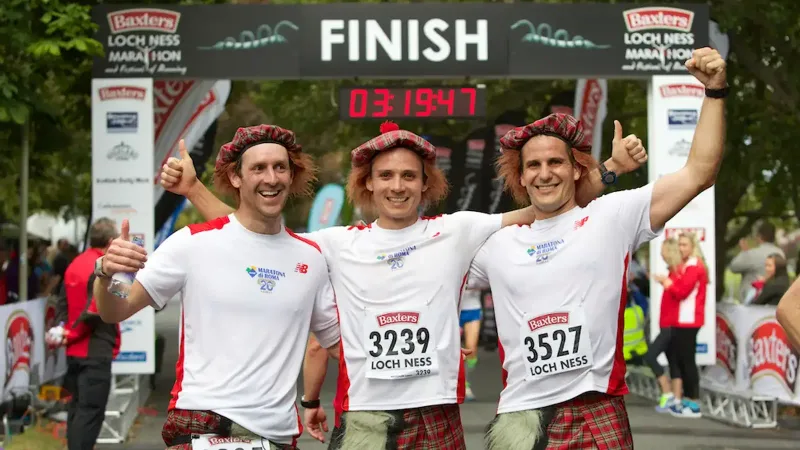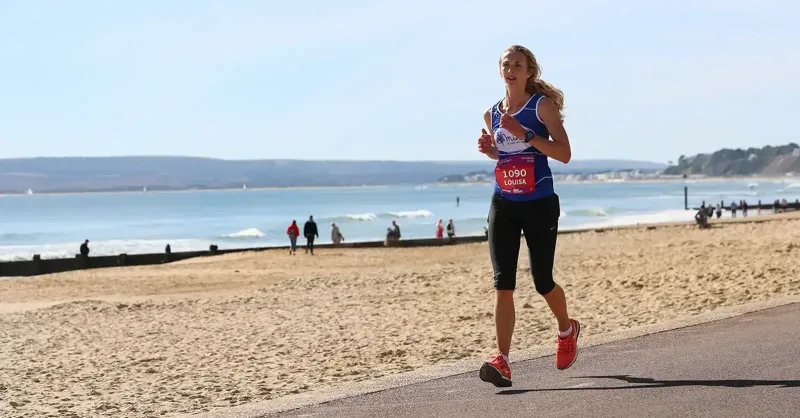Running tips for beginners: How to start running
Running can provide a superb release, both physically and mentally, and is an exercise that anyone can do. It’s free, works all areas of the body and is perfect for brand-new runners looking to lose weight and build fitness just as much as it is for seasoned runners looking to shave seconds off their record time.
There are plenty of benefits of running for even as little as 30 minutes - from stronger bones to improved mental well-being and even better skin. Throwing your trainers on and heading out for a jog can make a huge positive impact on your day, week or even your life. One of the best things about running is that anyone can do it and getting started isn’t as hard as it can seem.
That’s right - everyone can run regardless of age, size or fitness level. At findarace, we love to see people taking on new challenges. but know it can be daunting to get going and stick to something that can be difficult to start with. To help you get started, we’ve put together a collection top running tips for beginners to help you enjoy your runs and keep getting out there chasing a new challenge.
Getting equipped: What should I wear for a run?
Don’t worry, we’re not suggesting you go straight for all the gear, no idea but if sport generally isn’t your thing, you might not think you have the right equipment. The good news is that expensive designer gym wear isn’t necessary, it’s more important to feel comfortable with your clothing and find a shoe that will help you avoid injuries.
Getting kitted out for running can be done affordably. Your phone has plenty of options to track runs with built-in health apps or the wealth of running apps like Strava or Nikerun, available for download and use for free.
Avoiding 100% cotton t-shirts is a good rule to follow as they tend to trap heat and sweat and remember not to overdress - once you’ve started a run and your heart rate increases, your body can feel up to 15 degrees warmer so don’t wear any more layers than you need to. Add a pair of shorts and a respectable pair of socks and you’re dressed for success without spending a penny.
The only part you need to invest in is a good pair of running shoes. Without diving into too much detail, the best thing to do is understand your running gait. Most people under or overpronate and this impacts what kind of shoes your feet need.
If your foot rolls too far inward when it strikes the ground, that’s overpronation, and if the opposite happens and your foot rolls too far outward that’s known as under pronation. Too much of either can lead to pain and injuries, something that you’ll be keen to avoid when you’re just starting to run.
Head to a running shop and get a professional gait analysis - these are usually free and once you know what you need, you can always head online for cheaper deals on the exact type of running shoes you need to support your feet properly and prevent injuries.
Getting started - walking and running intervals
Depending on your fitness levels and how much cardio activity you’re used to doing, it’s likely that you’re trying to ramp up to a 5k to get moving or are looking to build on your cardio fitness. This means that trying to run the whole distance straight away is going to be very difficult - but the good news is that it’s amazing how quickly you’ll see progression if you build up gradually.
There are plenty of simple training plans to follow such as the hugely popular NHS Couch To 5k plan. Consisting of weekly podcasts that you listen to whilst you run with walk breaks, the programme is scheduled over 9 weeks to gently progress you from intervals to running the full distance.
Week One is a 5 minute walk with a 1-minute run and walking intervals.
Week Three is a 5-minute walk with 2 repetitions of 1-and-a-half minutes of running, 1-and-a-half minutes of walking, 3 minutes of running and 3 minutes of walking.
By week 5 you’ll be running for 20 minutes continuously.
Whilst that may seem far out of reach at the start of the plan, you’ll be surprised just how quickly your body will adapt and improve. If you’re looking for a nicely structured way to start running, it is important to find the right programme or running coach to suit you. Fortunately, that is easier than ever these days, and to help you on your way here are a couple of top suggestions:
8 Week Beginners Program from Runner’s World.
5K Running Program from Bupa.
If your fitness starting point is a little higher, you can always skip forward a couple of weeks to find what suits you best. The important thing about running at the start is that it is only about your progress and not about comparison. Enjoy yourself!
Choose the right surface to run on
If you’ve never run before, you might feel a little self-conscious about it. The good news is that no one will be paying attention to you and if they do, they’ve got no idea how long you’ve been running for or where you’re running to. Running really is the most accessible sport as you can go for a jog anywhere, but it is worth thinking carefully about what kind of surface you choose to start on.
Grass is usually soft and a little kinder on your joints and muscles as it offers reduced impact. This makes it ideal for beginners, but be aware that the softer landing means it can feel a little slower than road running.
Pavements or road running offers a reliable, firm surface, but pounding the pavement isn’t very forgiving, with shin splints presenting as the most common running injury for beginners. Try to mix road runs with sections on grass to mix things up a bit.
Running machines are perfect for all weathers and offer a really good middle ground of a firm surface and a little bit of give to reduce impact. A common finding for beginner runners who have only ever run on a treadmill is that running outside is quite a different sensation; this is because your form will be different, but don’t worry you’ll soon adapt.
Take short, easy steps - run easy!
Running has plenty of technical aspects to it that aren’t apparent when you start. The proper running form technique isn’t necessarily something you’ll instinctively know how to do and it is likely that your form won’t be as efficient as it could be.
The good news is that the more you run, the better your body develops coordination. And whilst you’re building that up, try to take shorter strides that don’t allow you to overstretch. Run easy and focus on looking ahead, keeping your shoulder blades neutral and use your core.
Pace yourself - don’t go off too fast
Whether you’ve been for a couple of runs and want to test yourself out, or used to run a few years ago and try to get straight back into the swing of things, there is one key running mistake almost all runners make: setting off too quickly.
A flying first km might be fun to start with, but your body might not be ready to take the new stresses of running. This can lead to pain, injuries or crucially frustration at not being able to complete the distance you’d planned to complete. Aim to maintain the same page for the entire distance of the run and keep it steady. The more you successfully run at an even pace, the faster your pace will get as your fitness and stamina scale up.
It is going to be hard - and that’s normal!
At first, running might be tough and this makes staying motivated vital to enjoying your runs enough to carry on all the way to a 5k and beyond. The hardest run you’ll ever do is the first, followed by the second and the third - you might even feel like you’re not doing well enough or that running isn’t for you.
Remember it’s an entirely new skill that will take practice and a little perseverance. Running has a bit of a steep learning curve for your body, and delayed onset muscle soreness is entirely normal.
Is it OK for beginners to run every day?
Recovery between runs is important for brand-new and experienced runners alike, with the only difference being the time required to recover changing depending on physical fitness levels and distances covered.
If you’re a beginner, you need to avoid injury or overexertion so it is best to run every other day. This gives your body time to recover and adjust to your new schedule without you losing any of your hard-earned progress. It is important to listen to your body - if you’re feeling sore or something doesn’t feel right take a rest day and get back to it once you’re feeling better.
Try cross-training
Variety is the spice of life and the same saying applies to fitness and training. Mixing up your routine with different forms of exercise can help to reduce injury, increase flexibility and engages totally different sets of muscles to the core groups than running requires.
Activities like swimming, yoga or pilates are a fantastic choice as these all help you work on stability and strengthening of supportive smaller muscles around your joints. Cycling is another good option whilst a little strength training can really work wonders for improving your running power and durability.
What next?
By following our top beginner running tops, you’ll be able to get out there and take on the new challenge of running a little more prepared. If you’re looking for a goal to aim for, why not take a look at our 5k events or check out your local Parkrun?
More from the guides

Winter running guide: how to keep running when it’s dark, cold, and you’d rather stay inside
03 Nov 2025
Running through a British winter takes a bit more planning and a lot more persistence than the sun-drenched summer evening jogs. The mornings are dark, the…
Read on
Best Winter Running Events in the UK 2025–26
19 Oct 2025
Looking for winter running motivation? Discover the best UK events for 2025–26, from festive 5K runs and scenic trails to fast half marathons that keep you…
Read on
Fastest 10k races in Scotland – Inverness, Glasgow and beyond
07 Sept 2025
Looking for a quick 10k in Scotland? From the record-breaking River Ness race to Glasgow’s fast park loops and new coastal courses, discover the events that…
Read on
The fastest 10k races in the South West
07 Sept 2025
Explore the fastest 10k races in the South West. From flat seafront routes in Weymouth and Exmouth to the city streets of Southampton and Exeter, find the…
Read on